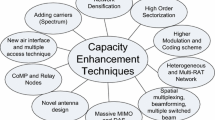Abstract
In this paper, we focus on a generalized multi-user distributed antenna system (DAS), where the antenna elements (AEs) are divided into antenna clusters and the antenna clusters are randomly deployed in the coverage area. The mobile terminals equipped with M AEs each are supposed to be uniformly distributed in the coverage area. We are motivated to study the impact of the deployment of antenna elements on the system performance. In the model of consideration, the deployment of antenna elements is characterized by the antenna cluster size V, i.e., the number of AEs within each antenna cluster, and the distribution of the antenna clusters. With the assumption that the antenna clusters are uniformly deployed in the coverage area, the impact of the antenna cluster size V on the uplink sum rate capacity is particularly investigated. The mean square access distance (MSAD), a function of V, is proposed as a reasonable metric instead of the uplink sum rate capacity. From the analysis of the asymptotic behavior of MSAD, we derive an approximate closed-form expression for the expectation of MSAD over system topologies. Then, it is concluded that the ergodic uplink sum rate capacity can be improved due to access distance reduction by scattering AEs further only when V > M. An approximate closed-form expression for the relative variance of MSAD is also derived. And we conclude that the outage uplink sum rate capacity can be improved due to macro-diversity by scattering AEs further only when V ≤ M. In other words, when V ≤ M, the ergodic uplink sum rate capacity can not be improved by scattering AEs further, when V > M, the outage uplink sum rate capacity can not be improved by scattering AEs further. Finally, our analysis is well verified by Monte Carlo simulations.











Similar content being viewed by others
Notes
In this paper, we denote the DAS where the distributed AEs are absolutely scattered as “\(\mathcal {A}\)-DAS”.
The AEs are scattered around to some extent, but not scattered absolutely as an“\(\mathcal {A}\)-DAS”. The antenna cluster size is an important parameter to characterize the DASs with intermediate states.
If V is maximized, i.e., all the antenna elements are deployed together, we can obtain a traditional co-located antenna system (CAS). If V = 1, we can obtain an absolute DAS (\(\mathcal {A}\)-DAS), where the antenna elements are absolutely scattered.
V is the antenna cluster size.
The M nearest AEs of MT i.
References
Zhang J, Andrews JG (2008) Distributed antenna systems with randomness. IEEE Trans Wirel Commun 7(9):3636–3646
Andrews JG, Choi W, Heath RW Jr (2007) Overcoming interference in spatial multiplexing MIMO cellular networks. IEEE Wirel Commun 14(6):95–104
Ni Z, Li D (2004) Effect of fading correlation on capacity of distributed MIMO. In: Proc. IEEE Personal, Indoor and Mobile Radio Commun., vol 3, pp 1637–1641
Xiao L, Dai L, Zhuang H, Zhou S, Yao Y (2003) Information-theoretic capacity analysis in MIMO distributed antenna system. In: Proc. IEEE Veh. Technol. Conf., pp 779–782
Hasegawa R, Shirakabe M, Esmailzadeh R, Nakagawa M (2003) Downlink performance of a CDMA system with distributed base station. In: Proc. IEEE Veh. Technol. Conf., pp 882–886
Feng W, Li Y, Gan J, Zhou S, Wang J, Xia M (2008) On the size of antenna cluster in multi-user distributed antenna systems. In: Commun. Networking in China, 2008, pp 1101–1105
Saleh AAM, Rustako AJ, Roman RS (1987) Distributed antennas for indoor radio communications. IEEE Trans Commun 35(12):1245–1251
Zhuang H, Dai L, Xiao L, Yao Y (2003) Spectral efficiency of distributed antenna systems with random antenna layout. IET Electron Lett 39(6):495–496
Roh W, Paulraj A (2002) Outage performance of the distributed antenna systems in a composite fading channel. In: Proc. IEEE 56rd Veh. Technol. Conf., pp 1520–1524
Roh W, Paulraj A (2002) MIMO channel capacity for the distributed antenna systems. In: Proc. IEEE Veh. Technol. Conf., pp 706–709
Clark MV, Willis TM III, Greenstein LJ et al (2001) Distributed versus centralized antenna arrays in broadband wireless networks. In: Proc. IEEE 53rd Veh. Technol. Conf., vol 1, pp 33–37
Choi W, Andrews JG (2007) Downlink performance and capacity of distributed antenna systems in a multicell environment. IEEE Trans Wirel Commun 6(1):69–73
Gan J, Li Y, Xiao L, Zhou S, Wang J (2007) On sum-rate and power consumption of multi-user distributed antenna system with circular antenna layout. ERASIP Trans. WCN., vol 2007, Article ID 89780, 9 pp. doi:10.1155/2007/89780
Feng W, Li Y, Zhou S, Wang J, Xia M (2009) On the optimal radius to deploy antennas in multi-user distributed antenna system with circular antenna layout. In: Proc. Inter. Conf. Commun. Mobile Computing, pp 56–59
Feng W, Li Y, Zhou S, Wang J, Xia M (2009) Uplink sum capacity evaluation of multi-user distributed antenna systems. Int J Electron Commun. Online in Science Direct. doi:10.1016/j.aeue.2008.11.008
Feng W, Li Y, Zhou S, Wang J, Xia M (2009) Downlink capacity of distributed antenna systems in a multi-cell environment. In: Proc. IEEE Conf. Wireless Commun. Networking, pp 1–5
Telatar E (1999) Capacity of multi-antenna Gaussian channels. Eur Trans Telecommun ETT 10(6):585–596
Goldsmith AJ, Greenstein LJ (1993) Measurement-based model for predicting coverage areas of urbanmicrocells. IEEE J Sel Areas Commun 11(7):1013–1023
Acknowledgements
The authors gratefully acknowledge the anonymous reviewers for their helpful suggestions. We would also like to thank the input from Jingyao Zhang (Tsinghua University) and Nan Hua (Georgia Institute of Technology).
Author information
Authors and Affiliations
Corresponding author
Additional information
This work is partially supported by China Nature Science Foundation (90204001) and Tsinghua-ETRI of Korea collaborative research project and China’s 863 Project (2006AA01Z282) and Program for New Century Excellent Talents in University (NCET).
Rights and permissions
About this article
Cite this article
Feng, W., Li, Y., Gan, J. et al. On the Deployment of Antenna Elements in Generalized Multi-User Distributed Antenna Systems. Mobile Netw Appl 16, 35–45 (2011). https://doi.org/10.1007/s11036-009-0214-1
Published:
Issue Date:
DOI: https://doi.org/10.1007/s11036-009-0214-1




